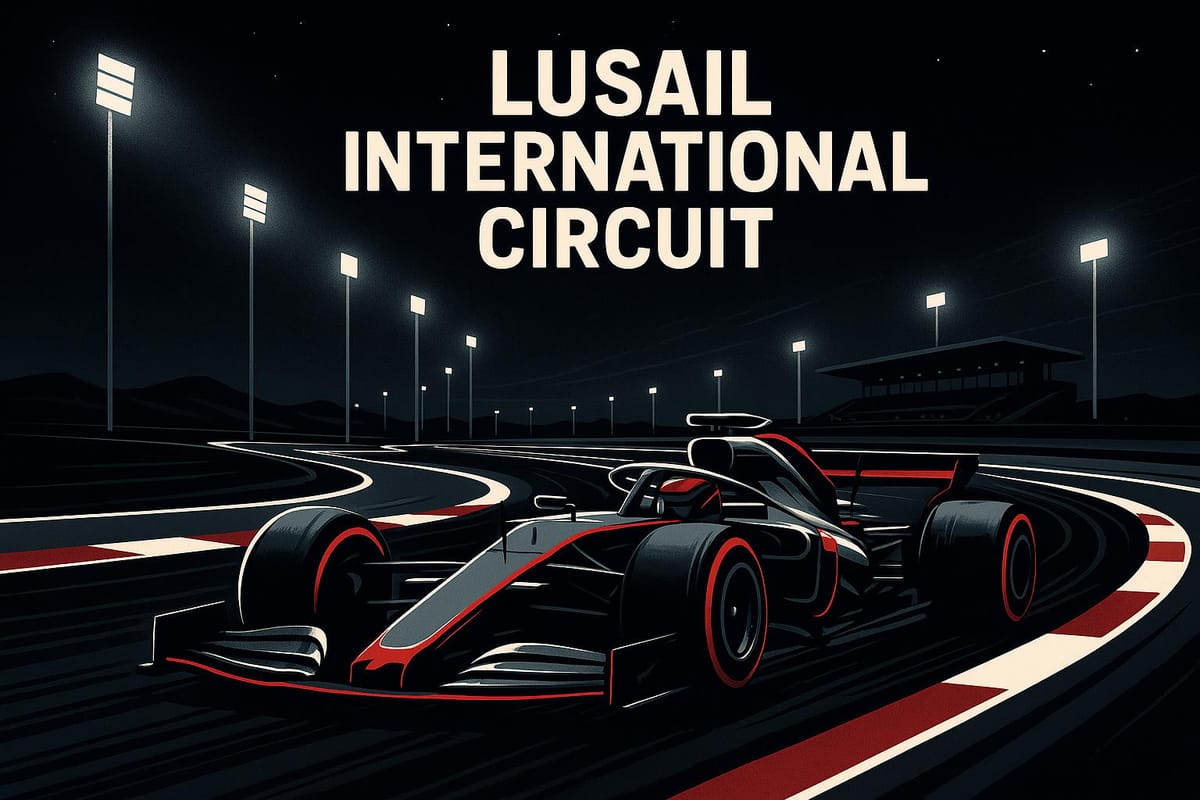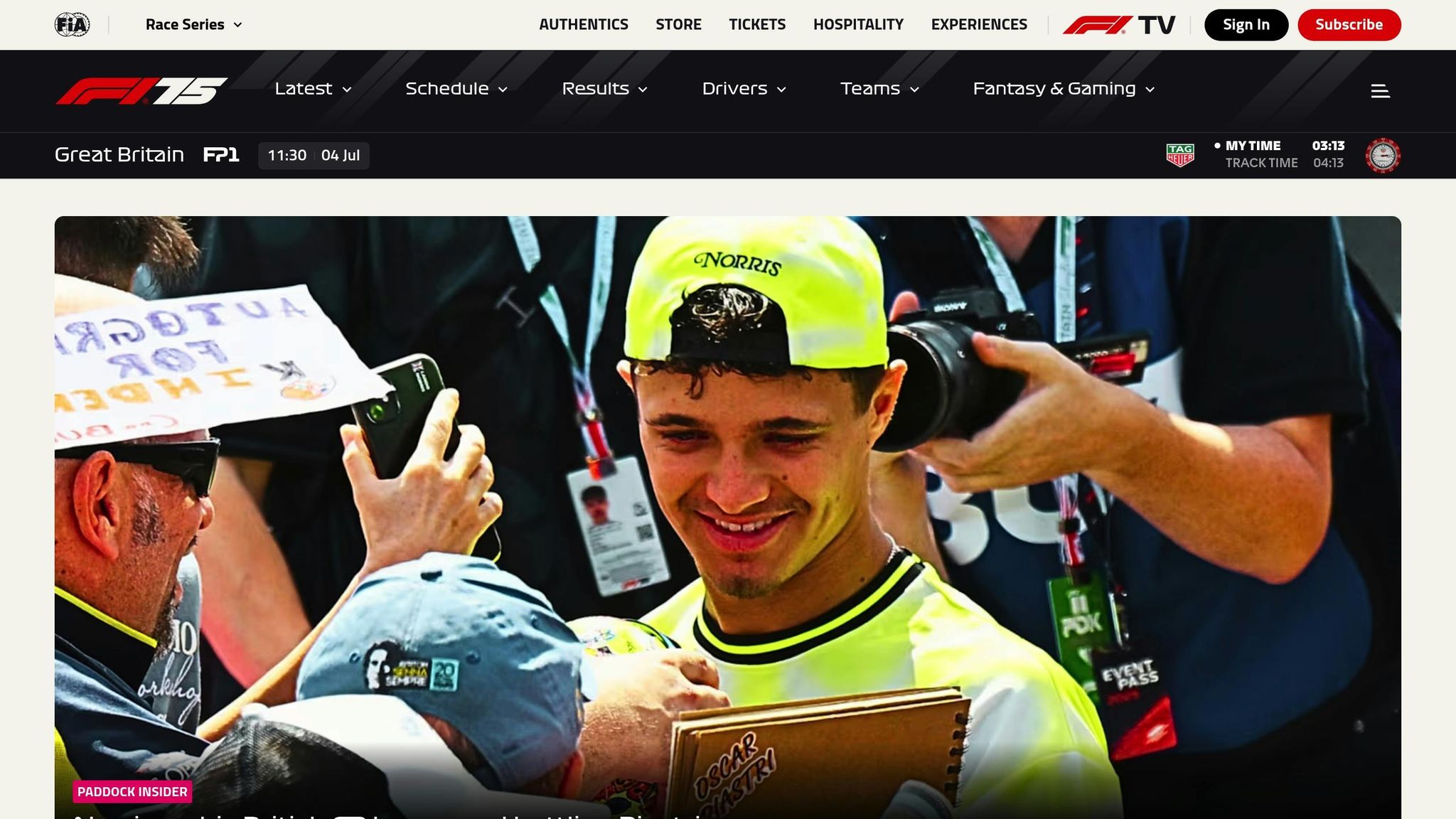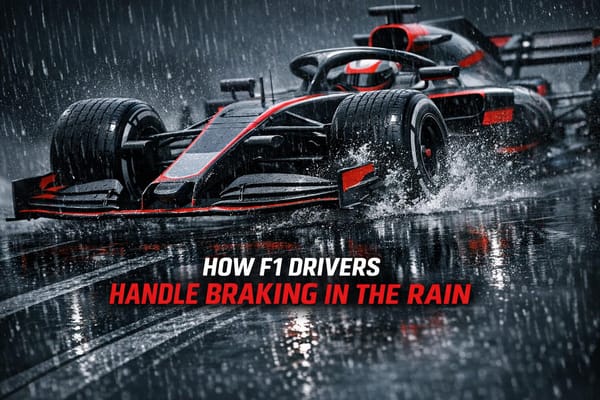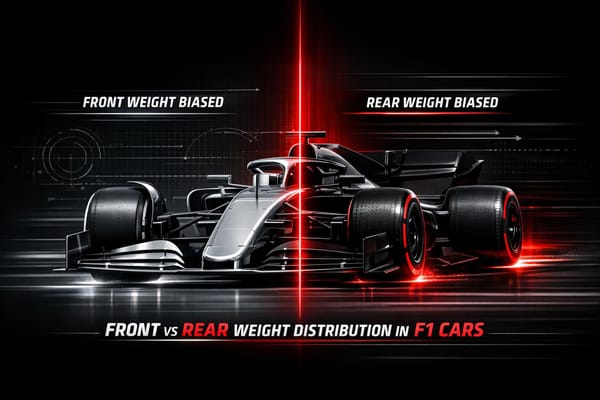Lusail International Circuit: Qatar’s Ascent in Formula 1 and Its Technical Demands
Explore how the Lusail International Circuit in Qatar is reshaping Formula 1 with its unique challenges, night racing, and economic impact.

The Lusail International Circuit in Qatar has quickly become a key venue in Formula 1, blending cutting-edge design with the challenges of desert racing. Built for $58 million, this 5.419 km track hosted its first F1 event in 2021 and secured a 10-year contract starting in 2023. It features night racing under 3,600 floodlights, a 1.068 km main straight, and 16 demanding turns designed to test drivers and teams alike.
Key Takeaways:
- Track Features: High-speed layout with 68% full-throttle racing, a 1.068 km main straight, and a smooth surface for optimized aerodynamics.
- Desert Challenges: Sand, extreme heat, and high humidity push cars and drivers to their limits.
- Night Racing: Cooler conditions improve race performance but introduce unique visual demands.
- Technical Adjustments: Teams prioritize aerodynamic efficiency, tire management, and precise setups to succeed.
- Economic Impact: Part of Qatar’s Vision 2030, the circuit boosts tourism and global recognition.
With its high-speed design and desert conditions, Lusail has reshaped F1 strategies while solidifying Qatar's position in global motorsports.
Is Qatar The Most Demanding Track Of The Season? | Oracle Virtual Laps
Qatar's Entry into Formula 1

Qatar's involvement in Formula 1 ties directly to its National Vision 2030, a plan aimed at transforming the country into a dynamic, knowledge-driven economy. Hosting major sporting events like Formula 1 is seen as a key step toward diversifying the economy and gaining global recognition. The country's economic prospects are promising, with GDP expected to grow from $162 billion in 2022 to $208 billion by 2024. H.E. Ambassador Dr. Hend Al-Muftah, Qatar's Permanent Representative to the United Nations Office at Geneva, highlights the broader significance of sports:
"Sport is a powerful communications tool that can support international efforts to strengthen, and renew diplomatic relations in times of crisis."
Qatar's approach to premier sports events is about more than just financial returns. The nation has adopted "sports diplomacy" as a strategy to enhance its international standing and build lasting global partnerships. This strategy not only boosts Qatar's reputation but also influences the technical and competitive operations at Lusail International Circuit. The record-breaking attendance of 154,973 at the 2024 Qatar Grand Prix is a testament to the region's growing passion for Formula 1. In the following sections, we’ll explore the upgrades to Lusail and how Qatar is leveraging Formula 1 to bolster its global visibility.
Lusail's Construction and Upgrades
Transforming Lusail International Circuit into a Formula 1-ready venue required extensive upgrades and investments. Originally built in 2004, the circuit underwent a significant overhaul to meet Formula 1's high standards while maintaining its identity as a motorsports hub. Key improvements included expanding the grandstand to accommodate 52,000 fans and adding a record-setting 50 pit boxes to enhance the facility's capabilities.
Amro Al-Hamad, CEO of Lusail International Circuit, shared the circuit's vision:
"LIC's goal is absolutely to become one of the world's top motorsports hubs, and part of achieving this ambition is to ensure that we are offering fans and drivers the very best of the best in terms of facilities."
Lusail's dual certifications from the FIA (Grade 1) and FIM (Grade A) make it one of only two venues globally capable of hosting Formula 1, MotoGP, and the World Endurance Championship. The success of the 2023 Formula 1 Qatar Airways Qatar Grand Prix, which drew 120,000 attendees over the weekend, demonstrates Lusail's ability to host world-class events. These upgrades are a cornerstone of Qatar's vision for advancing motorsports in the Middle East.
F1's Middle East Expansion
Qatar's addition to the Formula 1 calendar complements other Middle Eastern races in Bahrain, Abu Dhabi, and Saudi Arabia, further solidifying the region's presence in the sport. Qatar stands out with its focus on sustainability and cultural integration, investing in cutting-edge venues and employing night racing to reduce energy use while delivering a visually stunning spectacle.
Maryam AlJassim, a marketing professional, underlined the broader impact of hosting Formula 1:
"Doha being the heart of world-beloved sporting events like Formula 1 has more benefits than just showing off our beautiful city. It sets us up as global leaders as hosts and ensures a future where we can continue to excel."
Beyond the thrill of race weekends, hosting Formula 1 drives economic growth through tourism, technology transfer, and international business opportunities. The financial boost from these events supports further advancements in technology and team performance. Qatar’s focus on sports diplomacy and its investment in sports media, exemplified by collaborations with BeIN Sports, has firmly established the nation as a key motorsports hub in the region.
Track Layout and Technical Features
Track Specifications
The Lusail International Circuit is a high-speed track that demands sharp engineering and strategic planning. Spanning 5.419 km (3.367 miles), the circuit cuts through the Qatari desert with 16 turns that challenge both drivers and their machines. Over the course of 57 laps, drivers cover a total race distance of 307.8 km (191.258 miles).
One of the standout features of the track is its 1.068 km (0.664 mile) main straight, which has a huge impact on team strategies. With cars running at full throttle for 68% of the lap, it puts intense pressure on power units and aerodynamic setups. Adding to the complexity is the 18.9-second pit lane time loss, which forces teams to carefully time their stops.
| Track Feature | Specification |
|---|---|
| Total Length | 5.419 km (3.367 miles) |
| Number of Turns | 16 |
| Main Straight | 1.068 km (0.664 miles) |
| Race Laps (F1) | 57 |
| Race Distance (F1) | 307.8 km (191.258 miles) |
| Pit Lane Time Loss | 18.9 seconds |
The current lap record is held by Lando Norris, who clocked a 1:22.384 in his McLaren MCL38 during the 2024 Qatar Grand Prix. This record highlights the circuit's capacity for thrilling, high-speed racing.
Track Characteristics
Lusail's desert location brings its own set of challenges. To combat sand from the surrounding environment, the circuit is bordered by artificial grass, which plays a key role in keeping the track clean throughout the race weekend.
The track surface is exceptionally smooth, allowing teams to lower their cars' ride heights to improve aerodynamics. According to Gary Gannon, Senior Race Engineer for Nico Hulkenberg at MoneyGram Haas F1 Team:
"The circuit is very high-speed and pushes the cars to their limit in terms of performance, and also the driver's performance."
The layout features a mix of medium and high-speed corners, with the most demanding section being Turns 12 to 14. This sequence - a triple-apex right-hander - challenges drivers with speeds nearing 200 mph (over 300 km/h). Many compare this section to Istanbul Park’s Turn 8, renowned for its physical toll on drivers.
George Russell offered his take on the circuit’s character, likening it to Mugello in Italy:
"It's very, very fast and flowing. Not a lot of time to relax and then obviously, we've got this big long straight."
The track’s open design makes it highly vulnerable to wind, which can disrupt car balance and driver confidence, especially in the faster sections. Drivers also face the challenge of managing 36 gear changes per lap, requiring precision and mechanical finesse.
Effects on Race Strategies
The unique blend of Lusail’s features forces teams to fine-tune both aerodynamic setups and tire strategies. The long main straight and numerous high-speed corners create a tricky balancing act for downforce levels.
George Russell pointed out the strategic dilemma:
"There's lots of medium-speed corners, fourth, fifth-gear corners, there's only one slow-speed corner, which I think is going to be really interesting, and then followed on to a really long straight. So it's going to be difficult because I think there'll be a lot of split in strategy in terms of where people run the downforce because the straight's so long yet you've got so many corners where you need that downforce."
Tire management plays a critical role here due to the high-speed layout and abrasive track surface. The desert environment adds another layer of difficulty, as Gannon explains:
"The track also gets very sandy, so the track conditions are challenging at the beginning of the weekend, but then improves massively throughout, so that's another factor we have to build into our expectations."
The single DRS zone on the main straight amplifies the importance of track position, as overtaking opportunities are limited outside of this area. Combined with the significant pit lane loss, teams must carefully weigh the need for fresh tires against the risk of losing valuable track position. This makes qualifying performance critical, as starting higher up the grid often determines the outcome on a circuit where overtaking is at a premium.
Climate and Technical Challenges
Desert Climate and Sand Effects
Qatar's desert climate sets the stage for some of the harshest conditions in Formula 1, pushing both drivers and machines to their limits. The 2023 Qatar Grand Prix offered a brutal reminder of these extremes, with cockpit temperatures soaring past 122°F (50°C) and humidity levels hitting 75%.
These conditions took a heavy toll on drivers. Esteban Ocon, for instance, vomited inside his helmet mid-race, while Alex Albon required medical attention for severe heat exposure.
"I felt close to fainting in that race, I have never experienced anything like it before... Inside the cockpit it was over 50 [degrees Celsius]. You've got your fireproofs on, race suit on, the physicality of the car. It's just crazy." – George Russell, Mercedes Driver
Charles Leclerc echoed this sentiment:
"This is the toughest race I think for every driver in Formula One of our career, for everybody. I don't believe [anyone] that says it's not." – Charles Leclerc, Ferrari Driver
Adding to the challenge, sand particles swept onto the track create a slippery surface, drastically reducing grip. Yuki Tsunoda shared his experience:
"I didn't want to open the visor because sand was also coming through the visor and I can feel the sand is in my eyes... But if I close it, it's just insane that amount of heat. Much worse than expected." – Yuki Tsunoda, AlphaTauri Driver
This layer of sand forces teams to adjust their strategies to cope with reduced traction. These punishing conditions highlight the importance of alternative solutions, such as night racing, to make the event more manageable.
Night Racing Benefits
To counteract the desert’s grueling daytime heat, the Qatar Grand Prix has shifted to night racing. This change provides much-needed relief, with track temperatures during the night race staying around 97°F (36°C) - a notable improvement compared to daytime highs that regularly exceed 104°F (40°C).
Racing under thousands of floodlights creates a distinctive atmosphere while offering cooler conditions. However, teams must still carefully analyze how the lower temperatures affect tire grip and car aerodynamics.
Night racing also introduces unique visual challenges. Drivers must adapt their braking points and visual cues to account for the differences in visibility under artificial lighting. The contrast between illuminated areas and shadows can impact depth perception, requiring precise adjustments.
Tire Strategies and Surface Effects
The Lusail circuit underwent resurfacing in 2023, and its aggressive asphalt significantly altered tire wear patterns. Giorgio Barbier explained:
"The sand makes the asphalt very slippery, and this often results in graining and accentuated thermal degradation." – Giorgio Barbier
This smooth yet abrasive surface can cause cold graining unless tires are warmed up properly. As Pierre Alves pointed out:
"The solution is to manage the warm-up of the tyre properly. Then you don't have this micro sliding and therefore no graining." – Pierre Alves
To handle the high stress at Lusail, Pirelli typically selects its hardest tire compounds, as the demands on tires here rival those of circuits like Suzuka and Silverstone. However, the "pyramid" curbs at Lusail caused significant issues during the 2023 race, leading to micro-cuts and tire damage. This prompted the FIA to impose a maximum stint length of 18 laps. Mario Isola elaborated:
"It's not just the geometry of the kerbs, because these kerbs are used in many other circuits. It's the time and the speed they stay on the kerbs that is important." – Mario Isola
In response to these challenges, the curbs were modified ahead of the 2024 race to reduce the risk of tire sidewall damage. While these changes offer teams more flexibility in their tire strategies, they must still navigate the delicate balance between thermal management, wear rates, and the ever-present issue of sand-induced grip loss.
Team and Driver Adjustments at Lusail
Car Setup Requirements
Lusail's high-speed corners demand a unique car setup compared to more conventional tracks. Teams often focus on aerodynamic efficiency rather than outright straight-line speed. To achieve this, they implement an aggressive aerodynamic package with higher downforce levels on both the front and rear wings, favoring a front-heavy configuration. Specifically, there’s typically a 5-point offset between the front and rear wings, with the front wing carrying more load to counter understeer in the circuit's long, sweeping corners.
The suspension setup at Lusail is pushed to the edge of what the cars can handle mechanically. Thanks to the track's flat surface, teams crank up suspension stiffness to near maximum, creating a highly responsive platform for rapid direction changes. Engineers prioritize a time trial-oriented geometry, emphasizing speed over comfort. Tire pressure strategies also play a key role here: during races, lower tire pressures are used to manage wear, while qualifying sessions often see higher pressures to maximize short-term performance.
| Setup Component | Lusail Configuration | Key Benefit |
|---|---|---|
| Front Wing Aero | 47 points | Improved turn-in response |
| Rear Wing Aero | 43 points | Balanced downforce levels |
| Suspension Stiffness | Near maximum | Optimal responsiveness |
| Tire Pressures | Reduced for race | Better tire wear management |
These tailored setups directly influence the skills drivers must bring to the track, as explored below.
Driver Skills Required
Lusail's layout demands precision driving, particularly through its high-speed sections. The flowing nature of the track requires drivers to consistently hold the ideal racing line. Even minor deviations can result in significant time losses and quicker tire degradation. This makes tire management a critical skill, as drivers need to carefully modulate throttle and braking inputs to preserve performance over a stint.
Adding to the challenge is the transition from daylight to night racing. The shift to artificial lighting alters visual markers and braking points, requiring drivers to adapt quickly. Strict track limit enforcement further raises the stakes, as maintaining precise positioning is crucial - especially during tight wheel-to-wheel battles. The combination of aerodynamic challenges, tire management, and nighttime conditions makes Lusail a true test of precision and adaptability.
Simulation and Practice Preparation
Preparation for Lusail goes beyond on-track adjustments, with teams heavily relying on cutting-edge simulation tools to fine-tune setups and driver performance. Given the limited historical data for this relatively new circuit, teams conduct extensive virtual sessions, often completing hundreds of laps in simulation. These sessions test various aerodynamic setups and suspension configurations, helping teams narrow down their options and familiarize drivers with the circuit's rhythm and unique demands.
Once the race weekend begins, practice sessions become critical for validating simulation results. Teams use this time to test tire compounds, evaluate brake cooling systems, and gather real-time data to adapt to conditions. Lusail’s desert environment adds another layer of complexity, as temperatures can shift rapidly during sessions. This forces teams to stay agile, making quick adjustments as needed. The combination of simulation work and on-track preparation highlights the meticulous effort required to tackle Lusail's technical challenges effectively.
Race Results and Competition Patterns
Race Winners and Results
Since its introduction, Lusail has played a pivotal role in reshaping late-season championship battles, thanks to its distinctive challenges.
Max Verstappen showcased his dominance at the 2024 Qatar Grand Prix, where he clinched the Drivers' Championship title before the season's final race. His victory earned him 25 points, pushing his total to an impressive 429 points - an unassailable 80-point lead over second-place Lando Norris. This performance reflected Verstappen's ability to thrive under pressure, a skill well-suited to Lusail's demanding layout.
The 2024 race results further revealed the circuit's knack for shaking up the competitive order. Charles Leclerc secured second place (18 points), while Oscar Piastri finished third (15 points), both contributing vital points to the Constructors' Championship battle. George Russell, despite receiving penalties, managed a fourth-place finish, highlighting how strategic errors can be costly at Lusail. Pierre Gasly's fifth-place result underscored the importance of precise car setups and strategies, as teams that adapt well to Lusail's challenges often reap significant rewards.
These individual performances not only impact driver standings but also ripple through team strategies and championship outcomes.
Effects on Team Competition
The Qatar Grand Prix has cemented itself as a critical event in deciding championship standings, particularly for the Constructors' Championship. Following the 2024 race, McLaren held a narrow 21-point lead over Ferrari (640 to 619), with Red Bull trailing at 581 points. This tight margin ensured the Constructors' Championship would be decided in the season's final race, emphasizing Lusail's role as a key factor in high-stakes competition.
McLaren's recent success at Lusail reflects how the circuit rewards teams with strong tire management and strategic setups. Both Lando Norris and Oscar Piastri have consistently delivered points-paying finishes, navigating the track's challenges with precision.
Adding to the complexity is the Sprint format at Qatar, which introduces additional opportunities to earn points during Sprint qualifying and the Sprint race. This forces teams to make tough decisions - chasing Sprint points while ensuring their cars are ready for the main race. The penalties incurred by Norris and Russell during the 2024 race reshuffled finishing positions and altered championship standings, demonstrating how Lusail's technical demands and strict regulations can dramatically influence outcomes.
These dynamics highlight Lusail as a circuit where precision, strategy, and adaptability are non-negotiable.
Circuit Comparisons
Lusail's unique layout directly shapes race competition, making it stand out on the Formula 1 calendar. Its mix of high-speed corners and accelerated tire degradation fosters frequent overtaking opportunities. For instance, the 2023 Qatar Grand Prix saw 108 overtakes, a testament to the circuit's ability to deliver thrilling, wheel-to-wheel action.
Compared to other tracks, Lusail offers a distinct set of challenges. Bahrain International combines a night race ambiance with a moderate climate, while the Hungaroring is often likened to "Monaco without walls" due to its tight, twisty nature. In contrast, Lusail's desert conditions and flowing layout demand drivers to master tire management and maintain precise racing lines. Addressing misconceptions about the circuit, Amro Al-Hamad, Executive Director of Qatar Motor & Motorcycle Federation, remarked:
"I know from a competitive driver point of view that there is a lot of overtaking that is going to be done, against all of the speculation that has been spread, that this is a straight-line kind of circuit, which it's not."
– Amro Al-Hamad
The circuit's main straight offers a prime overtaking zone, while its flowing sections create additional opportunities for strategic positioning and tire management. The physical demands of high G-forces in long corners, combined with the desert climate, often test driver endurance and heat management, factors that can make or break a race.
These elements make Lusail a defining stage in the championship fight, where every decision counts.
Conclusion: Lusail's Role in Modern Formula 1
The Lusail International Circuit has quickly become a standout venue in Formula 1's global journey - offering much more than just another race. Built in under a year with a price tag of $58 million, this Qatari circuit is a testament to the country's commitment to hosting premier motorsports. That investment has already paid off, with the circuit now hosting what its chief executive, Amro Al-Hamad, proudly calls the "three jewels" of motorsport.
"We're hosting the three jewels, I do call them, and I don't know if that's being called that outside or not, but it's the three jewels, the MotoGP, the WEC and Formula 1 and in the region nobody else does that." – Amro Al-Hamad
Lusail's design and conditions have reshaped how teams approach race weekends. Its high-speed layout, combined with the challenges of managing tires under desert heat and the unique demands of a night race, pushes teams to adapt their strategies. The circuit's 16 corners add another layer of complexity, rewarding preparation and precision.
Beyond the technical aspects, Lusail plays a pivotal role in boosting motorsports in the region. By hosting events across multiple disciplines, it strengthens Qatar's influence in the world of racing while also driving economic benefits through sports tourism. For example, events like Singapore's Grand Prix have shown how motorsports can transform local economies, drawing an estimated 450,000 extra visitors and contributing approximately $1.4 billion over its first decade.
With a 10-year contract locking Qatar into the Formula 1 calendar until 2032, Lusail's future is bright. Its world-class facilities and infrastructure underscore its importance to the sport's global ambitions. As Amro Al-Hamad puts it:
"It is putting us on the map now, not only in the region, but worldwide".
FAQs
How does the desert climate at the Lusail International Circuit affect F1 race strategies and car performance?
The Challenges of Racing at Lusail International Circuit
The desert climate at Lusail International Circuit presents unique challenges, with track temperatures often soaring above 96.8°F. Such extreme heat speeds up tire wear and raises the risk of overheating, making tire strategy a critical part of race planning. On top of that, the sandy track surface adds another layer of difficulty by increasing abrasiveness and creating unpredictable grip levels.
Drivers face their own set of physical hurdles, as cockpit temperatures can climb to a scorching 122°F, pushing their endurance and concentration to the limit. To tackle these conditions, teams make adjustments to cooling systems and fine-tune car setups, aiming to maintain both performance and reliability. Thriving at Lusail demands a delicate balance of heat management, tire care, and driver resilience.
What makes the Lusail International Circuit technically challenging for Formula 1 teams and drivers?
Lusail International Circuit: A Test of Precision and Performance
Stretching 3.34 miles (5.38 km), the Lusail International Circuit is a demanding track with 16 corners that push both drivers and their cars to the limit. The layout blends high-speed straights with medium- to high-speed corners, creating intense lateral G-forces. To navigate this, teams must fine-tune aerodynamic setups and carefully manage tire performance to stay competitive.
Adding to the challenge is Lusail's desert climate. Race weekends typically see temperatures hover around 77°F (25°C), which directly impacts tire wear and engine cooling. Teams have to adjust their strategies to cope with the heat, balancing performance with reliability. These combined factors make Lusail a standout challenge on the F1 calendar, testing every aspect of racing precision.
How is Qatar using the Lusail International Circuit to strengthen its global influence in motorsports and sports diplomacy?
Qatar is making waves in global motorsports with the Lusail International Circuit, hosting premier events like Formula 1, MotoGP, and the FIA World Endurance Championship. Known for its state-of-the-art facilities and world-class accreditation, the circuit has become a key player in the Middle East’s sports scene, showcasing Qatar’s dedication to hosting top-tier events.
But Qatar’s ambitions go beyond motorsports. The country is leveraging sports as a powerful tool for global engagement, focusing on development and cultural diplomacy. By organizing high-profile events and supporting sports-driven initiatives, Qatar is carving out a role as a center for international collaboration and progress in the world of sports.
Related posts
- Bahrain International Circuit: From Desert Debut to DRS Battles Under the Lights
- Jeddah Corniche Circuit: The High-Speed Street Track Redefining Night Racing in Saudi Arabia
- Miami International Autodrome: The Newest Showstopper in F1’s American Dream
- Las Vegas Strip Circuit: Glitz, Speed, and Strategy in the Heart of Sin City




